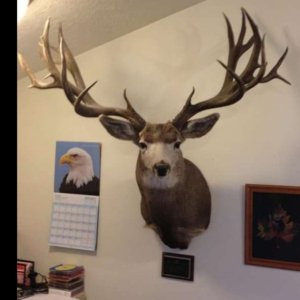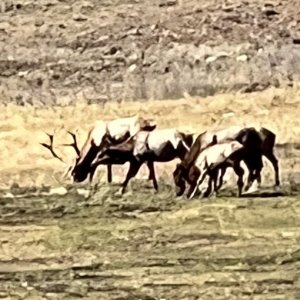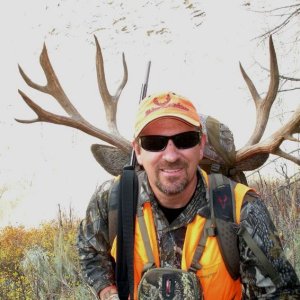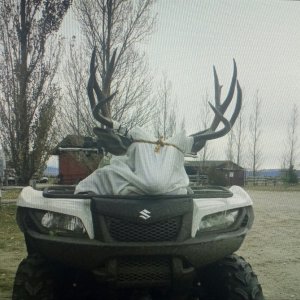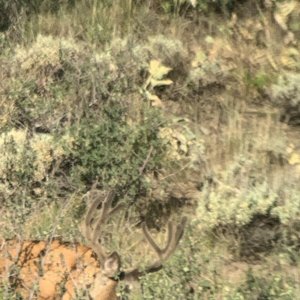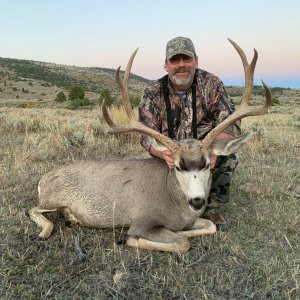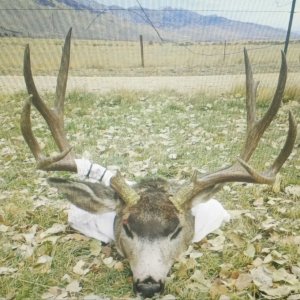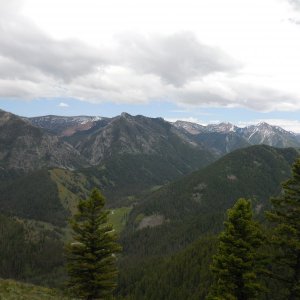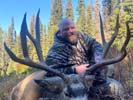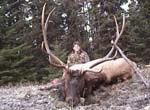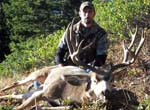B
BQHIdaho
Guest
The impacts to mule deer from motorized vehicles can be broadly summarized in three categories.
Disturbance ? Many species of wildlife, including mule deer, are displaced from habitats adjacent to roads and motorized trails. In highly motorized areas, the ability of mule deer to make efficient use of otherwise suitable habitat near motorized roads and trails is compromised. The degree of displacement varies by type of activity and level of use. Research at the Starkey Experimental Station in Oregon has shown that elk are affected by motorized vehicle use at a distance of ? mile. The effects on mule deer were not as pronounced but deer generally were displaced into habitats that may have been less suitable. Displacement from preferred habitats can affect diet and energy conservation and thus survival and reproduction.
Buck vulnerability ? The increased popularity of OHV?s combined with the lack of regulations on their use, have provided hunters access to areas that were once difficult to get to and which provided important security habitat for deer. In heavily roaded areas, bucks are harvested by hunters at higher rates affecting the numbers of mature animals in the population. In response to this issue, Fish and Game has reduced antlered permit levels in controlled hunts, implemented short general hunting seasons, restricted huntind during November, and implemented a hunting season travel regulation in some units.
Hunting opportunity ? Hunting is one of the most important recreational activities on our public lands and should receive priority consideration in the decisions made by land management agencies. Our surveys consistently show that deer hunters want to hunt in areas where they encounter few other hunters and few motorized vehicles.
Whether you believe that there are too many roads and motorized trails in your hunting areas or not, you should let the land management agencies know your feelings. Opportunities to influence road and trail designation don't come along often. To get involved, contact the Forest Service or Bureau of Land Management office near your hunting area. Your local Fish and Game regional office can help you make the proper contacts, and are more than willing to help you to get involved.
?Roadless areas, in general, represent some of the best fish and wildlife habitat on public lands. The bad news is that there is nothing positive about a road where fish and wildlife habitat are concerned -- absolutely nothing.?
-------Jack Ward Thomas, retired Chief of the U.S. Forest Service
ATVs and Hunting: Impacts to Mule Deer
Randy Smith, Regional Wildlife Manager, Idaho Department of Fish and Game, Magic Valley Region
The use of ATV?s and motorbikes has increased astronomically in recent years. In 2005 more than 104,000 ATV?s and motorbikes were registered in Idaho; a 75% increase from 2001. Today an estimated 33% of Idahoans participate in off-highway vehicle (OHV) recreation with 20% using their ATV or motorbike primarily for hunting. Idaho currently ranks third in the United States after West Virginia and Wyoming in the percent of the population participating in OHV recreation.
As a mule deer hunter, why should this increasing trend in OHV use matter to you? Simply put, increased access to our wildlands influences the number of mule deer that we have and your opportunity to hunt them. That is because increased human activities influence how effectively mule deer can use available habitat; and thereby influences reproduction, fawn survival, buck vulnerability and ultimately deer numbers.
Deer hunter numbers in Idaho haven't changed much in the past 20 years. What has changed is access. The use of four-wheel drive trucks, ATV?s and motorbikes has allowed us to push into areas that were once remote, secure, and hard to get to. The result has often been fewer mature bucks, increasing conflicts between hunters, and more dissatisfied mule deer hunters.
A survey conducted by the Fish and Game in 1987 defined Idaho?s highest quality hunting product as ?an unroaded natural setting with an abundance of wildlife species, few other hunters, the opportunity to pursue animals of all age classes, and a chance to use and practice hunting skills with companions?. Providing ?unroaded settings? with ?few other hunters? has become increasingly difficult over the years, but hunters continue to let us know that these elements make for a satisfying hunting experience. The current deer hunter survey is expected to yield additional insight regarding ATVs and hunting, access, and other issues affecting hunter satisfaction.
Managing motorized vehicle use and access can have substantial benefits to mule deer and the hunting experience. While Fish and Game is working hard with programs like Access Yes! to improve access to hunting areas, managing access within those hunting areas is an important tool for providing more mature bucks and areas with lower numbers of hunters. Seasonal road closures and Fish and Game?s motorized vehicle rule have been employed to help address these issues.
In Idaho, the use of motorized vehicles in our hunting areas is largely regulated by the three primary land management agencies: the U.S. Forest Service, the Bureau of Land Management, and the Idaho Department of Lands. Recently, there have been few restrictions on how motorized vehicles could be used
Some Finer ?Points? on Mule Deer
Have you ever wondered about mule deer hair? We know it changes color from one season to the next, but there is much more to it than meets the eye. As you all know, mule deer live in a variety of climates throughout the West, from forests to deserts. To help survive extreme temperature fluctuations, they have some interesting fur adaptations.
At any given time, mule deer have several different types of hair in their coat. For example, an adult mule deer coat is composed of large guard hairs, intermediate guard hairs, mane hairs, and woolly under-hairs. Fawns have tufts of white-tipped hairs.
Mule deer coats change according to the animal?s age as well as to seasonal temperatures. Mule deer have four different pelages: natal (newborn), juvenile (fawn to yearling), adult summer, and adult winter. The adult winter pelage is the most complex, having all of the hair types, with each type at its greatest diameter. The summer coat does not have underfur and is longer with more slender guard hairs lying at an inclined angle to the skin. This ?design? is thought to shade the skin and to provide for efficient heat loss.
Mule deer molt their coats twice a year?spring and autumn. The autumn molt occurs when deer are in their best body condition with good food resources still available, which is key to producing a warm coat sufficient to meet winter?s energy demands.
(Information obtained from the Biomimicry Database at database.biomimicry.org.)
Mule Deer Update
An unauthorized ATV trail (circled) on this mountain in the Targhee National Forest north of Spencer has allowed unlawful access by ATVs to on state and most federal lands. But that is starting to change. Several forest offices are going through a ?travel planning? process or an in-depth review of their motorized road and trail system in response to the ?National Travel Management Rule? published in the Federal Register in 2005.
The opportunity to evaluate motorized recreation on our national forests happens rarely. The implications to mule deer management and deer hunting are significant, and Fish and Game is committing substantial resources to provide recommendations that are in the best interest of mule deer and mule deer hunting. However, it is important that you, as hunters, let your opinions be known regarding travel management in your hunting area. The final decisions on motorized travel will have long-lasting effects on deer management and hunting.
Disturbance ? Many species of wildlife, including mule deer, are displaced from habitats adjacent to roads and motorized trails. In highly motorized areas, the ability of mule deer to make efficient use of otherwise suitable habitat near motorized roads and trails is compromised. The degree of displacement varies by type of activity and level of use. Research at the Starkey Experimental Station in Oregon has shown that elk are affected by motorized vehicle use at a distance of ? mile. The effects on mule deer were not as pronounced but deer generally were displaced into habitats that may have been less suitable. Displacement from preferred habitats can affect diet and energy conservation and thus survival and reproduction.
Buck vulnerability ? The increased popularity of OHV?s combined with the lack of regulations on their use, have provided hunters access to areas that were once difficult to get to and which provided important security habitat for deer. In heavily roaded areas, bucks are harvested by hunters at higher rates affecting the numbers of mature animals in the population. In response to this issue, Fish and Game has reduced antlered permit levels in controlled hunts, implemented short general hunting seasons, restricted huntind during November, and implemented a hunting season travel regulation in some units.
Hunting opportunity ? Hunting is one of the most important recreational activities on our public lands and should receive priority consideration in the decisions made by land management agencies. Our surveys consistently show that deer hunters want to hunt in areas where they encounter few other hunters and few motorized vehicles.
Whether you believe that there are too many roads and motorized trails in your hunting areas or not, you should let the land management agencies know your feelings. Opportunities to influence road and trail designation don't come along often. To get involved, contact the Forest Service or Bureau of Land Management office near your hunting area. Your local Fish and Game regional office can help you make the proper contacts, and are more than willing to help you to get involved.
?Roadless areas, in general, represent some of the best fish and wildlife habitat on public lands. The bad news is that there is nothing positive about a road where fish and wildlife habitat are concerned -- absolutely nothing.?
-------Jack Ward Thomas, retired Chief of the U.S. Forest Service
ATVs and Hunting: Impacts to Mule Deer
Randy Smith, Regional Wildlife Manager, Idaho Department of Fish and Game, Magic Valley Region
The use of ATV?s and motorbikes has increased astronomically in recent years. In 2005 more than 104,000 ATV?s and motorbikes were registered in Idaho; a 75% increase from 2001. Today an estimated 33% of Idahoans participate in off-highway vehicle (OHV) recreation with 20% using their ATV or motorbike primarily for hunting. Idaho currently ranks third in the United States after West Virginia and Wyoming in the percent of the population participating in OHV recreation.
As a mule deer hunter, why should this increasing trend in OHV use matter to you? Simply put, increased access to our wildlands influences the number of mule deer that we have and your opportunity to hunt them. That is because increased human activities influence how effectively mule deer can use available habitat; and thereby influences reproduction, fawn survival, buck vulnerability and ultimately deer numbers.
Deer hunter numbers in Idaho haven't changed much in the past 20 years. What has changed is access. The use of four-wheel drive trucks, ATV?s and motorbikes has allowed us to push into areas that were once remote, secure, and hard to get to. The result has often been fewer mature bucks, increasing conflicts between hunters, and more dissatisfied mule deer hunters.
A survey conducted by the Fish and Game in 1987 defined Idaho?s highest quality hunting product as ?an unroaded natural setting with an abundance of wildlife species, few other hunters, the opportunity to pursue animals of all age classes, and a chance to use and practice hunting skills with companions?. Providing ?unroaded settings? with ?few other hunters? has become increasingly difficult over the years, but hunters continue to let us know that these elements make for a satisfying hunting experience. The current deer hunter survey is expected to yield additional insight regarding ATVs and hunting, access, and other issues affecting hunter satisfaction.
Managing motorized vehicle use and access can have substantial benefits to mule deer and the hunting experience. While Fish and Game is working hard with programs like Access Yes! to improve access to hunting areas, managing access within those hunting areas is an important tool for providing more mature bucks and areas with lower numbers of hunters. Seasonal road closures and Fish and Game?s motorized vehicle rule have been employed to help address these issues.
In Idaho, the use of motorized vehicles in our hunting areas is largely regulated by the three primary land management agencies: the U.S. Forest Service, the Bureau of Land Management, and the Idaho Department of Lands. Recently, there have been few restrictions on how motorized vehicles could be used
Some Finer ?Points? on Mule Deer
Have you ever wondered about mule deer hair? We know it changes color from one season to the next, but there is much more to it than meets the eye. As you all know, mule deer live in a variety of climates throughout the West, from forests to deserts. To help survive extreme temperature fluctuations, they have some interesting fur adaptations.
At any given time, mule deer have several different types of hair in their coat. For example, an adult mule deer coat is composed of large guard hairs, intermediate guard hairs, mane hairs, and woolly under-hairs. Fawns have tufts of white-tipped hairs.
Mule deer coats change according to the animal?s age as well as to seasonal temperatures. Mule deer have four different pelages: natal (newborn), juvenile (fawn to yearling), adult summer, and adult winter. The adult winter pelage is the most complex, having all of the hair types, with each type at its greatest diameter. The summer coat does not have underfur and is longer with more slender guard hairs lying at an inclined angle to the skin. This ?design? is thought to shade the skin and to provide for efficient heat loss.
Mule deer molt their coats twice a year?spring and autumn. The autumn molt occurs when deer are in their best body condition with good food resources still available, which is key to producing a warm coat sufficient to meet winter?s energy demands.
(Information obtained from the Biomimicry Database at database.biomimicry.org.)
Mule Deer Update
An unauthorized ATV trail (circled) on this mountain in the Targhee National Forest north of Spencer has allowed unlawful access by ATVs to on state and most federal lands. But that is starting to change. Several forest offices are going through a ?travel planning? process or an in-depth review of their motorized road and trail system in response to the ?National Travel Management Rule? published in the Federal Register in 2005.
The opportunity to evaluate motorized recreation on our national forests happens rarely. The implications to mule deer management and deer hunting are significant, and Fish and Game is committing substantial resources to provide recommendations that are in the best interest of mule deer and mule deer hunting. However, it is important that you, as hunters, let your opinions be known regarding travel management in your hunting area. The final decisions on motorized travel will have long-lasting effects on deer management and hunting.

